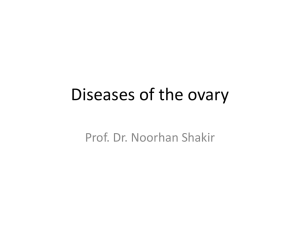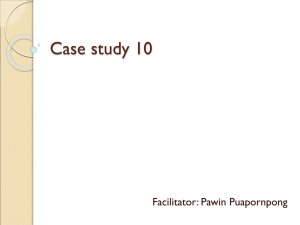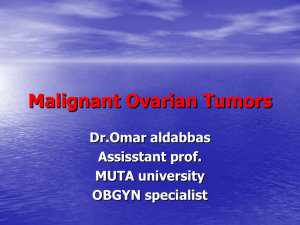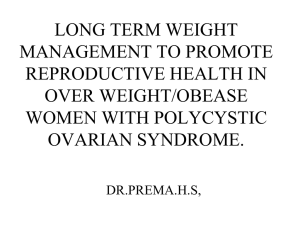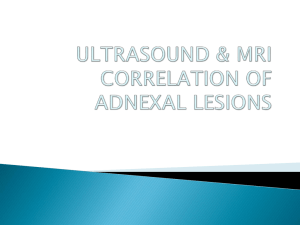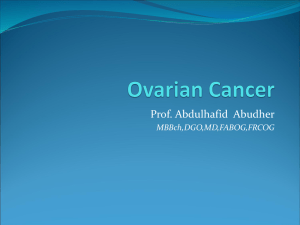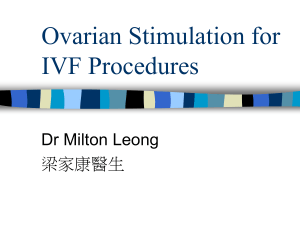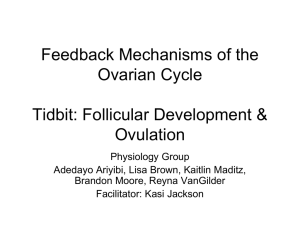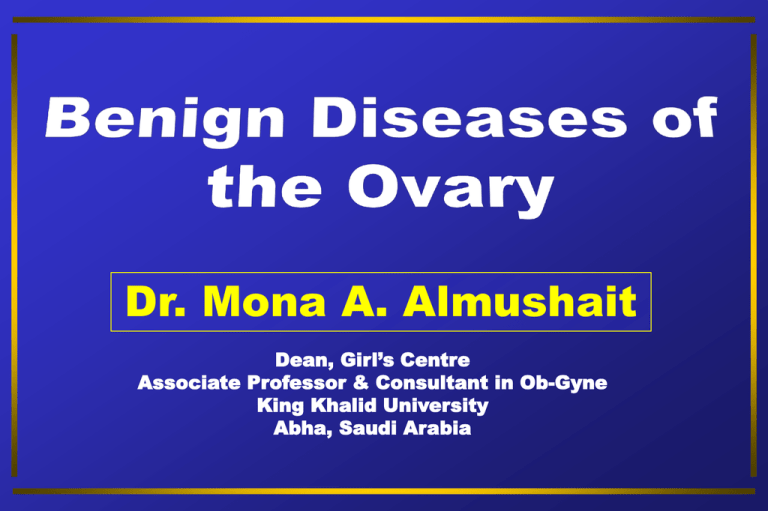
Dr. Mona A. Almushait
Dean, Girl’s Centre
Associate Professor & Consultant in Ob-Gyne
King Khalid University
Abha, Saudi Arabia
The Ovary
• The human ovary has a striking
propensity to develop a wide variety
of tumors, most of which are benign.
• 90% of all ovarian tumors are
benign, although this varies with
age.
DIFFERENTIAL DIAGNOSIS OF OVARIAN MASSES
Pathogenesis
Functional
Specific Type
Follicular cysts
Lutein cysts
Polycystic ovaries
Inflammatory
Salpingo-oophoritis
Pyogenic oophoritis-puerperal, abortal, or related to
an intrauterine device
Granulomatous oophoritis
Metaplastic
Endometriomas
Premenarchal years-10% are malignant
Neoplastic
Menstruating years-15% are malignant
Postmenopausal years-50% are malignant
Benign Ovarian Tumors
Presentation:
• Asymptomatic
• Pain
• Abdominal swelling
• Pressure effects
• Menstrual disturbances
• Hormonal effects
• Abnormal cervical smear
Asymptomatic
• Many benign ovarian tumors are found
incidentally
during
a
routine
examination.
• Ultrasound was used in trials of
screening for ovarian cancer, the
majority of tumors detected were
benign.
Pain
•
•
•
•
•
•
•
•
Abdominal swelling
Acute pain
• If the tumor is very large
Torsion
• A benign mucinous cyst
Rupture
Haemorrhage
Infection
Chronic lower abdominal pain
Pressure of a benign ovarian tumor
More common if endometriosis
or infection is present
Functional Ovarian
Cysts and Tumors
•Occur only during menstrual life
Functional cyst
•
If the egg is not released, or if the sac-like
structure
closes up after the egg is
released and starts swelling up, a cyst is
formed.
•They may cause pelvic pain, a dull
sensation, or heaviness in the pelvis.
An image of a Functional cyst
Follicular cyst
• The commonest benign ovarian tumor, and may
be multiple and bilateral.
• Lined by one or more layers of granulosa cells,
develops when an ovarian follicle fails to
rupture.
• These cysts commonly occur during treatment
with clomiphene or human menopausal
gonadotropin.
A follicle cyst includes a thin smooth wall, anechoic contents,
and unilocular with good acoustic enhancement .
Lutein cyst
• Grows to 4–6 cm, and fails to regress normally
after 14 days.
• Persistent production of progesterone may
result in amenorrhea or delayed onset of
menstruation.
Hemorrhagic cyst
• Hemorrhagic corpus luteum cysts lead to
haemoperitoneum.
Hemorrhagic cyst with unusual appearance
simulating a neoplasm
Theca–lutein cyst
• May develop in association with the high
levels of hCG present in patients with a
hydatidiform mole or choriocarcinoma
• Patients undergoing ovulation induction
with gonadotropins or clomiphene
• Are usually bilateral
Surgical intervention if there is
haemorrhage.
Shows enlarged uterus in the centre and bilateral Theca lutein cysts.
The cyst on the left shows a breach in the capsule and the right cyst
with thin hemorrhagic area suggestive of impending rupture
Benign Neoplastic Ovarian Tumors
• Ovarian neoplasms may be divided generally by cell type
of origin into three main groups:
1. Epithelial
2. Stromal
3. Germ cell
•Taken as a group, the epithelial tumors are by far the
most common.
•Although the single most common benign ovarian neoplasm is
the benign cystic teratoma (dermoid cyst),which is
a germ cell tumor.
1. EPITHELIAL OVARIAN
NEOPLASMS
• Serous cystadenomas
• Mucinous cystadenomas
• Brenner cell tumors
Serous cystadenomas
• Commonest cystic ovarian tumors.
• Multilocular
Gross appearance of a mucinous (A) and serous (B) cystadenoma of the ovary.
The mucinous type is generally multiloculated and can be quite large.
Mucinous cystadenomas
• The second most common epithelial
tumor
• Unilateral and multilocular cysts
• About 85% are benign
• The fluid content consists of mucin
and the only treatment is to remove
the tumor surgically.
Gross image showing mucinous cystadenomas
tumor attached the left ovary.
Brenner tumor
• The Brenner cell tumors
are commonly
solid and occur in women after the age of 50
years.
• It is a small, smooth solid ovarian
neoplasm, usually benign and occasionally
bilateral.
• Treated by local excision.
Gross appearance of a cut-open Brenner tumor.
2. SEX CORD STROMAL
OVARIAN NEOPLASMS
• Hormone secreting tumors of the ovary.
• These
tumors
include
fibromas,
granulosa-theca cell tumors, and
Sertoli-Leydig cell tumors (Arrheno–
blastomas or androblastomas).
Granulosa–theca cell tumor
• The granulosa-theca cell tumors are arising from ovarian
granulosa cells, these tumors produce oestrogens and
constitute 3% of all solid ovarian tumors.
• They occur in any age group, from birth on, but more
commonly in the postmenopausal years.
• Promotes feminizing signs and symptoms, if arising
before puberty produce precocious menarche, precocious
thelarche, or premenarchal uterine bleeding during
infancy and childhood (precocious sexual development).
• In the reproductive age, prolonged oestrogen
stimulation results in cystic glandular hyperplasia
and irregular and prolonged vaginal bleeding.
• Postmenopausal bleeding may occur in older women
with granulosa-theca cell tumors. If the tumor is
histologically
benign,
the
treatment
is
Oophorectomy.
• If there is evidence of malignancy, Pelvic
clearance is indicated.
Granulosa–theca cell tumor
Sertoli-Leydig cell tumor
(arrheno-blastomas or androblastomas)
•
•
•
•
•
Androgen secreting tumor
Less frequent
It generally occurs in women under 30 years of age.
These tumors are comprised of Sertoli cells which are
normally found in testes and Leydig cells which secrete
testosterone.
The clinical manifestations include the onset of
amenorrhea, loss of breast tissue, virilizing effects, such
as hirsutism, deepening of the voice, clitoromegaly, and a
defeminizing change in body habitus to a muscular build.
•Diagnosis is by the exclusion of virilizing adrenal
tumors and the identification of a tumor in one ovary.
•Treatment is by the excision of the affected
ovary.
The surgical excised specimen of the ovarian mass
measuring 17 x 15 x 8.2 cm.
Ovarian fibroma
• A solid, encapsulated, smooth-surfaced tumor made
up of interlacing bundles of fibrocytes. It is not
hormonally active.
• It is associated with ascites caused by the transudation
of fluid from the ovarian fibroid. The flow of this
ascitic fluid through the transdiaphragmatic
lymphatics into the right pleural cavity may result
in Meigs' syndrome (ascites and hydrothorax in
association with an ovarian fibroma).
Gross appearance of an ovarian fibroma.
3. GERM CELL TUMORS
• Tumors of germ cell origin may
replicate stages resembling the
early embryo.
• Germ cell neoplasms can occur at any age.
• 12–15% of true ovarian neoplasms.
• They make up about 60% of ovarian
neoplasms occurring in infants and
children.
• The most common ovarian neoplasm is the
Benign cystic teratoma, a germ cell
tumor that can take on a great variety of
forms, with virtually all adult tissues being
represented within the mass.
Benign cystic teratoma
• Commonly referred to as a Dermoid cysts which are the
commonest solid ovarian neoplasm found in young women.
• Is composed primarily of ectodermal tissue (such as sweat
and sebaceous glands, hair follicles, and teeth), with some
mesodermal and rarely endodermal elements.
• Commonly asymptomatic unless they undergo torsion or
rupture and releases sebaceous material that causes
chemical peritonitis.
• Dermoid cysts are bilateral in 12% of cases, and becomes
malignant in approximately 2%.
• Treatment: Excision of the dermoid cyst
Gross appearance of a cut-open dermoid cyst.
Note the presence of hair-bearing skin.
Investigation
Bimanual examination involves palpating the organs
between both hand.
• Pelvic ultrasonography
• Tumor markers, such as
Serum
CA 125, may help to distinguish
between benign and malignant masses
• Laparoscopy
• Laparotomy
Serum CA 125
Ultrasonography
Laparoscopy
Management
• Surgical exploration
examination
and
pathologic
• Laparotomy
• Cytologic examination. A frozen-section
histologic diagnosis should be obtained
intraoperatively to exclude malignancy.
• The definitive treatment will depend on the type of
neoplasm, the patient's age, and her desire for
future childbearing.
• Benign epithelial ovarian neoplasms are generally
treated
by
Unilateral
Salpingooophorectomy.
• The contralateral ovary must be carefully inspected
to exclude a bilateral lesion.
• If the patient is young and nulliparous, the
ovarian neoplasm is unilocular, and there
are no excrescences within the cyst, an
Ovarian Cystectomy with preservation
of the ovary may be performed.
• In an older woman, a Total Abdominal
Hysterectomy
and
Bilateral
Salpingo-oophorectomy.
• Stromal cell neoplasms of the ovary are generally
treated
by
Unilateral
salpingooophorectomy when future pregnancies are
a consideration.
• Ovarian fibromas, even when associated with
ascites and a right hydrothorax (Meigs'
syndrome), are almost always benign and
might even be treated by Resection from
the ovary in a young woman.
For some very early tumors (stage 1,
low grade or low-risk disease), only
the involved ovary and fallopian tube
may be removed (called a
“Unilateral SalpingoOophorectomy," USO), especially
in young females who wish to
preserve their fertility and have
children.
If all of these structures
are removed, the surgery is
called a “Total Abdominal
Hysterectomy and
Bilateral SalpingoOophorectomy”
(TAH-BSO).
Ovarian Cystectomy
It is performed in those benign conditions of the
ovary in which a cyst can be removed and when it is
desirable to leave a functional ovary in place.


